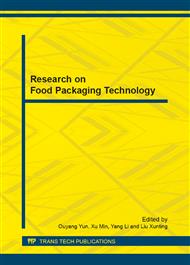p.140
p.148
p.152
p.156
p.162
p.167
p.171
p.175
p.180
Structural Effect of Thiol-Compounds on the Thiol-Ene Based UV Curable Adhesive
Abstract:
Three thiol-compounds with different functionalities were synthesized through esterification reaction which was prepared by 1, 4-butanediol, trimethylolpropane, and pentaerythritol and 3-mercapto propionic acid respectively. Thiol-compounds and polyurethane-acrylate prepolymer were blended with addition of photo-initiator in certain proportions in order to form polyurethane curing film under UV irradiation. The structure and properties of the thiol-compounds and the polyurethane curing film were characterized by NMR, FT-IR, and TG. The results showed that the thiol-ene addition reaction between the urethane acrylates and the thiol-compounds was preceeded. With the increase of functionality of mercaptopropionic acid ester, the thermal stability improved, and the T-peel strength enhanced. When the moral ratio of urethane acrylates and trimethylolpropane-3-mercapto propionic acid ester was 1:1, the adhesive showed the best mechanical properties and thermal stability with curing time 40s, T-peel strength 88N/m and 50 % mass loss at 369°C, respectively.
Info:
Periodical:
Pages:
162-166
Citation:
Online since:
November 2013
Authors:
Keywords:
Price:
Сopyright:
© 2014 Trans Tech Publications Ltd. All Rights Reserved
Share:
Citation:


